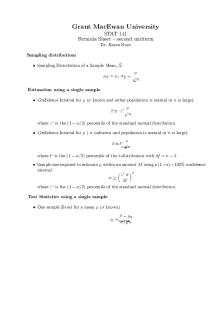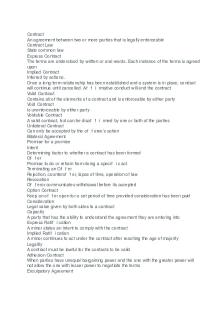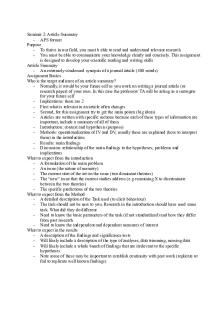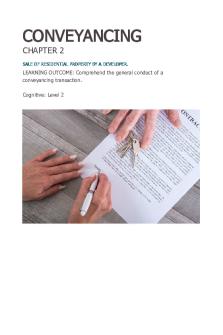Consolidations 2 AFR - Lecture notes 10-15 PDF

| Title | Consolidations 2 AFR - Lecture notes 10-15 |
|---|---|
| Course | Financial Reporting |
| Institution | University of Portsmouth |
| Pages | 9 |
| File Size | 539.2 KB |
| File Type | |
| Total Downloads | 34 |
| Total Views | 140 |
Summary
notes in accordance with acca...
Description
Consolidations 2: preparing a consolidated SOFP after the acquisition date Changes after the acquisition date There are a number of factors that need to be considered in order to prepare consolidated accounts after the acquisition date:
Requirements for the use of uniform accounting policies
The treatment of pre and post acquisition profits and reserves
Measurement of Goodwill
Measurement of Non-Controlling interest (NCI)
Uniform accounting policies Requirement for uniform accounting policies IFRS10 requires consolidated financial statements to be prepared using uniform accounting policies. In other words all companies in a group should use the same accounting policies, or in cases where this is not possible (e.g subsidiaries operating in different legal jurisdictions) adjustments should be made in the consolidated accounts to reflect uniform accounting policies. Note: In the examples and questions used on this course, the use of uniform accounting policies can be assumed.
Accounting treatment for pre and post-acquisition profits and reserves
Pre-acquisition profits/losses
Any retained profits/losses recorded by a subsidiary prior to the date of acquisition by a parent entity are referred to as pre-acquisition profits/losses. As we have seen in the previous session pre-acquisition profits/losses are taken into account in the calculation of goodwill. The preacquisition profits/losses of the subsidiary do not form part of the consolidated retained profits/losses of the group.
Post-acquisition profits/losses
Any retained profits/losses recorded by a subsidiary after the date of acquisition by a parent entity are referred to as post-acquisition profits/losses. As post-acquisition profits/losses occur during the period of control by the parent entity, these profits/losses are taken into account in the consolidated retained profits/losses of the group as follows:
The parent entities share of the post-acquisition profit/losses of the subsidiary are included in the consolidated retained profits/losses of the group The non-controlling interest (NCI) share of the post-acquisition profit/losses of the subsidiary are included in the subsequent calculation of NCI
How do we calculate pre-and post acquisition retained profits? We will know what the retained profits of the subsidiary are at the post acquisition balance sheet date, the question will tell us what the retained profits of the subsidiary were at the acquisition date (we will need this information to calculate goodwill). The difference between the retained profits of the subsidiary at the current date and the acquisition date will give you the post-acquisition retained profits. Other reserves Occasionally subsidiaries may record other reserves (e.g general reserve) as part of their equity. Other reserves are treated the same on consolidation as retained profits. So any pre-acquisition reserves will be taken into account in the calculation of goodwill, and any pre-acquisition reserves will be split between the consolidated reserves in the consolidated accounts and NCI. Goodwill in consolidated accounts after the date of acquisition Goodwill is measured as the difference between:
The consideration paid by the parent entity to acquire the interest in the subsidiary plus any NCI at acquisition; and The fair value of the net assets of the subsidiary at the acquisition date
So it is important to note that goodwill is always measured at the acquisition date, so to calculate goodwill the pre-acquisition reserves of the subsidiary are required, it does not change for post-acquisition reserves. The pre-acquisition reserves will be given to you in the question. The only subsequent changes to goodwill occur if there is an impairment charge
Measurement of NCI in consolidated financial statements after the date of acquisition
The measurement of NCI in consolidated statements of financial position after the balance sheet date will change because the NCI's shares of postacquisition reserves will need to be reflected in the measurement of the NCI. The NCI will be calculated as follows:
Worked example: Pharoe plc acquired its investment in Sphinx Ltd on 1 July 20X1 when the Retained Earnings of Sphinx Ltd was £10,000. The summarised Statements of Financial Position for each company as at 30th June 20X4 are:
Working 1 Ownership Structure
How much of Sphinx Ltd does Pharoe Plc own? 20,000 shares from the question. Sphinx Ltd has 25,000 shares in total (taken from its SOFP. So ownership % is 20,000/25,000 = 80%, and the Non-controlling interest (NCI) is 20%
EXAM IDEA In an exam you may consider working out without writing down both balance sheets in full, so in the above example (for aggregated balances e.g) Property, plant & Equipment (50+40+10) =100 Consolidated share capital, is always just the Share Capital of the Parent Company Balances such as Retained Earnings, Goodwill and NCI are just extracted from the workings However, it is important to show the workings and to show the numbers that you have aggregated to reach a balance e.gProperty, plant & Equipment (50+40+10) 100 As crucial marks will be awarded for the workings in an exam.
Impairment of goodwill Accounting for Impairment of goodwill The only subsequent adjustments to goodwill arise if an impairment in the valuation of goodwill is identified. If an impairment is required to goodwill the accounting for the goodwill impairment will depend on the method for valuing the NCI:
Partial Method for valuing NCI
If the partial method for valuing NCI is being used then goodwill is reduced by the amount of the impairment and the full charge is made to the consolidated group reserves for the impairment Fair Value (full goodwill method) of valuing NCI If the Fair value (full goodwill) method is being used then goodwill is reduced by the amount of the impairment, but the charge will be split proportionately (based on ownership) between the consolidated retained profits and the NCI.
Intra-group balances Adjustments for Intra-group balances
Where one company in a group has a receivable from another company in the group which has a corresponding payable then a consolidation adjustment should be made to eliminate these balances
Unrealised profits on intra-group transactions The elimination entry depends on whether the goods relating to the unrealised profit have been sold by the parent entity or the subsidiary Company a)
Sale of goods from parent company to subsidiary company
If an asset is sold from the parent company to the subsidiary company, then any unrealised profit on the transaction relates to the parent company and is entirely attributable to the group and is deducted in full from consolidated retained earnings and the related asset. The unrealised profit has been recognised in the accounts of the parent company, on consolidation its elimination will impact consolidated retained earnings in full.
b)
Sale of goods from subsidiary company to parent company
If an asset is sold from the subsidiary company to the parent company, then any unrealised profit on the transaction relates to the subsidiary company and is attributed proportionately as a reduction of consolidated retained earnings and non-controlling interests, because the net assets of the subsidiary are effectively reduced by the unrecognised profits. The unrealised profit has been recognised in the accounts of the subsidiary company, on consolidation the unrealised profit will be eliminated proportionately between consolidated retained earnings and non-controlling interests.
Example P plc owns 80% of the share capital of Q ltd. During the year ended 31 December 20X1 P plc sold goods to Q Ltd for £150,000 the goods had originally cost P plc £75,000. At 31 December 20X1 40% of the goods remained in inventory Calculate the unrealised profit at 31 December 20X1 and explain how the unrealised profit would be accounted for in the consolidated statement of financial position at 31 December 20X1 Total profit on sale of goods = £150,000-£75,000 = £75,000 Unrealised profit =£75,000 x 40% = £30,000 The unrealised profit of £30,000 will be subtracted from consolidated Inventories and also from the consolidated retained earnings. Explain how the treatment would differ if the goods had been sold from Q Ltd to P plc The unrealised profit of £30,000 would still be subtracted from consolidated Inventories, but the unrealised profit would be subtracted proportionately from Consolidated retained earnings (80%) and Non-controlling interests (20%). So Consolidated retained earnings would be reduced by 80% x £30,000 = £24,000 and Noncontrolling Interest by £6,000...
Similar Free PDFs

Lecture notes, lecture 2
- 3 Pages

2 - Lecture notes 2
- 5 Pages

LEY 1015 DE 2006
- 18 Pages

Lecture notes, lecture Chapter 2
- 11 Pages

Lecture notes, lecture formula 2
- 1 Pages

Critical Summary AFR 325
- 3 Pages

2 Biodiversity - Lecture notes 2
- 33 Pages

Chapter 2 - Lecture notes 2
- 30 Pages

Blaw 2 - Lecture notes 2
- 4 Pages

Chapter 2 - Lecture notes 2
- 4 Pages

Seminar 2 - Lecture notes 2
- 2 Pages
Popular Institutions
- Tinajero National High School - Annex
- Politeknik Caltex Riau
- Yokohama City University
- SGT University
- University of Al-Qadisiyah
- Divine Word College of Vigan
- Techniek College Rotterdam
- Universidade de Santiago
- Universiti Teknologi MARA Cawangan Johor Kampus Pasir Gudang
- Poltekkes Kemenkes Yogyakarta
- Baguio City National High School
- Colegio san marcos
- preparatoria uno
- Centro de Bachillerato Tecnológico Industrial y de Servicios No. 107
- Dalian Maritime University
- Quang Trung Secondary School
- Colegio Tecnológico en Informática
- Corporación Regional de Educación Superior
- Grupo CEDVA
- Dar Al Uloom University
- Centro de Estudios Preuniversitarios de la Universidad Nacional de Ingeniería
- 上智大学
- Aakash International School, Nuna Majara
- San Felipe Neri Catholic School
- Kang Chiao International School - New Taipei City
- Misamis Occidental National High School
- Institución Educativa Escuela Normal Juan Ladrilleros
- Kolehiyo ng Pantukan
- Batanes State College
- Instituto Continental
- Sekolah Menengah Kejuruan Kesehatan Kaltara (Tarakan)
- Colegio de La Inmaculada Concepcion - Cebu




